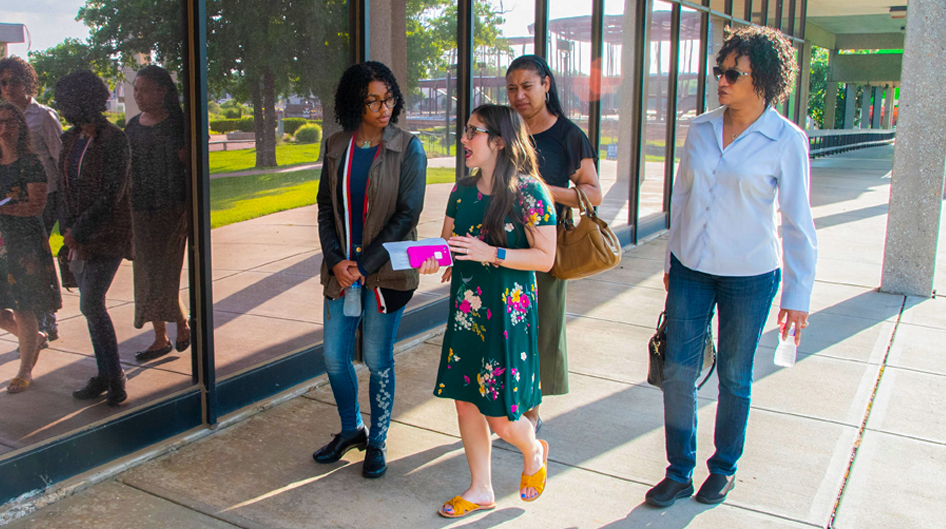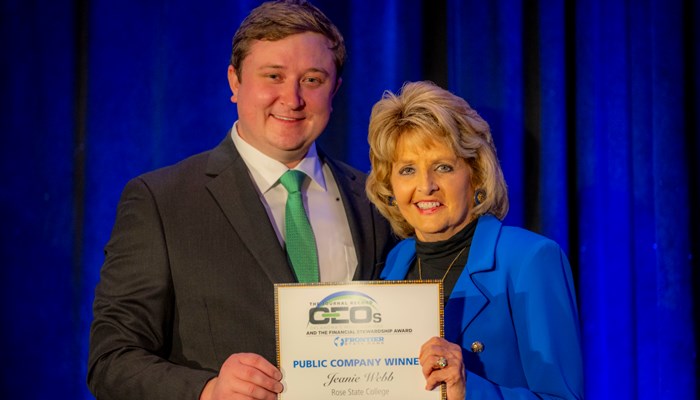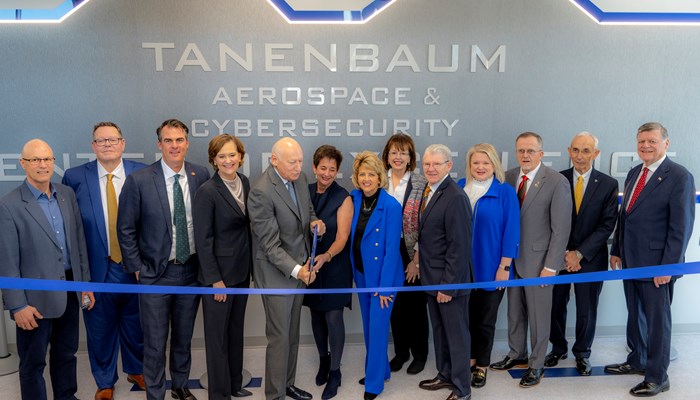Frequently Asked Questions About Applying to Rose State Published November 18, 2019
 College applicants are often bombarded with unknowns: how to begin the college application process, how to obtain scholarships, what programs to consider joining on campus.
College applicants are often bombarded with unknowns: how to begin the college application process, how to obtain scholarships, what programs to consider joining on campus.
Enter Rose State College’s Admissions Office. These folks field questions from hundreds of applicants each year and tend to see the same ones repeatedly.
To walk applicants through the most frequently asked questions about applying to Rose State, we tapped Donnie Anderson, Coordinator of Future Student Relations and Engagement. Anderson ensures all applicants are armed with the answers they need before signing on to become a Rose State Raider.
Where is Rose State located?
Because applicants hail from all over Oklahoma, they often aren’t as familiar with Midwest City, the home of Rose State, as central Oklahomans are. That’s what makes this the No. 1 question asked of Rose State recruiters.
“A lot of people haven’t heard of Rose State College,” Anderson says. “Usually where I start is, ‘We’re located in Midwest City, Oklahoma, right across the street from Tinker Air Force Base, 10 minutes from downtown Oklahoma City.’”
In fact, Midwest City was recently named to MONEY’s Best Places to Live 2019. This list ranks the top 100 cities, towns and neighborhoods in the United States and shows how great of a community we have in Midwest City and Del City.
What kind of housing does Rose State offer?
Rose State offers top-notch student housing for up to 180 students in The Village, a gated community of on-campus, fully furnished, apartment-style residences. The Village places students close to their classes and educational activities, eliminating the stress of commuting to and from school. Not only that, but students have peace of mind knowing they’re protected by campus security and have access to a community safe room.
Students can unwind with the help of amenities like the outdoor volleyball court, table tennis, pool tables, a TV lounge, and outdoor gazebo.
Floorplan options include two bedrooms and two bathrooms, or four bedrooms and two bathrooms. Each unit includes paid utilities (electric and Internet), and a kitchen with stove and oven.
If you have more questions about where to rest your head at Rose State, check out this spotlight on student housing, complete with its own FAQ section that dives into even more amenities, safety measures, info on roommate selection, and more. And keep in mind the 2019-2020 housing application goes live at 8 a.m. April 1. Bookmark this page and check back on that date to get a jump start on securing your spot.
What’s Midwest City like?
Students transplanting to a new city often want to know what’s in store for them in their new home. In Midwest City, Oklahoma’s eighth largest city with a population of about 54,000, necessities like grocery stores and laundromats are easy to find. Creature comforts like the new Warren Theatre, bowling and entertainment at the new Andy’s Altitude 1291, and the cultural event hotspot, the Rose State College Hudiburg Chevrolet Center, are abundant as well. Head to the Midwest City Convention and Visitors Bureau website for tons of resources to help you get acclimated.
Midwest City is also just a short drive down I-40 from Oklahoma City, making Rose State ideal for students looking to enjoy the amenities of living in big city, while attending classes away from the hussle and bustle. Not only does Rose State’s proximity to Oklahoma City provide access to the attractions and burgeoning restaurant scene, but offers opportunities to work and find jobs in the 27th largest city in the country. Many Rose State students choose to live in the OKC-metro and commute to the Rose State campus for classes.
Does Rose State offer scholarships?
“The answer is always: ‘Yes, we do,’” Anderson says. That resounding “yes” is thanks to Rose State College Foundation donors, who currently support over 400 student scholarships each semester.
Rose State makes it easy for students to take advantage of scholarships, requiring them only to have an ACT score on file before applying. Most Rose State students take advantage of scholarships. In fact, three-quarters of current full-time Rose State students are receiving some type of financial assistance.
Rose State awards $30 million annually in financial aid and offers a few types of scholarships, including the President’s Leadership Class, which pays for up to 16 credit hours and fees. The college inducts 150 students each year into the leadership class, taught by Dr. Kent Lashley, Vice President for Administrative Services. Students participate in community outreach projects and perform 60 hours of volunteer time in two years.
Students also may pursue the Frances White Hughes Scholarship if they’re majoring in a humanities field like photography, art, or foreign languages. This scholarship awards students $2,000 per semester and includes the completion of 90 hours as an intern in the RSC Performing Arts Theatre or Oklahoma City Civic Center Music Hall equivalent environment each semester.
Although scholarship applications open in January and close each year on March 1, you can peruse the scholarships page now to get your 2020-21 game plan in order, and take a closer look at some of those scholarships available to Rose State students in this blog post.
What programs does Rose State offer?
“The most popular program right now that I am asked about 93 percent of the time: nursing,” Anderson says. “Also, dental hygiene is huge, as is cyber security, and more general degrees like psychology, sociology, and business.”
Rose State offers academic programs in those areas and more. In fact, students have their pick of more than 60 academic programs that are specifically designed to transfer to a four-year college or university. To see a full rundown of programs, visit the college’s academic degrees page, where you’ll be directed to the Associate in Arts and Associate in Science page, and Associate in Applied Science page for more specific programming. After students understand what programs they can pursue, they’re curious about how their Rose State credits will transfer to another college or university.
Can I transfer Rose State credits to a four-year college or university?
Rose State credits transfer to any four-year college or university, including other Oklahoma institutions like the University of Oklahoma, University of Central Oklahoma, Oklahoma State University, and the University of Tulsa.
Many Rose State programs are specially designed for a seamless transition to specific institutions, like the cyber security program, led by Ken Dewey, which lines up students to transfer to the University of Oklahoma to earn a four-year degree. The bachelor track of nursing is a similar case, as it prepares students to earn their BSN from another college or university – in most cases from the University of Central Oklahoma, Anderson says.
Students who know which college or university they want to transfer to should reach out to the transfer office at the second institution to ensure transfer of credits.
What can I get involved in?
Students can get involved in more than 40 on-campus clubs and organizations, ranging from those in the health profession to political/civic engagement to recreational. Plus, if they don’t find a group that works for them, they can start their own.
Some popular organizations include the Student Nurses Association; Pre-Veterinary Medicine & Animal Welfare Club; Hispanic Students Association; Anime, Fandoms and Gaming; Baptist Collegiate Ministry; and Rose State Democratic Socialists.
You can find a comprehensive list on Rose State’s clubs and organizations page.
What’s a typical class size at Rose State?
“I talk to a lot of students graduating from schools with 40 students in their class, and it’s kind of intimidating for them to go into big research institutions where there could be 300 students in a classroom,” Anderson says. “They’re worried about going into those large classrooms and getting swallowed up.”
Rose State classes are unarguably small, which offers lots of advantages for students, Anderson says. With a 20:1 student-to-faculty ratio, it’s easy for professors to notice when students aren’t understanding and offer more one-on-one time with them. Not only that, the small sizes often lead to more engagement in classroom discussions.
Have a question that’s not covered here? Reach out to Rose State’s Admissions Office to talk to a recruiter today.



